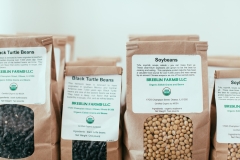There is a lot of information on the internet about soaking and sprouting grains, why and how to do it. It seems like there are as many twists and turns and opinions as there are websites that mention it, but most of the references seem to point back to materials published by the Weston A. Price Foundation.
The main reason given for soaking and sprouting (besides taste and variety) is that seeds contain compounds that inhibit digestion, a trait that is evolutionarily useful for preserving seeds so that they can pass through digestive tracts relatively unscathed. What this means for us as eaters is that when we eat grains, we aren’t able to extract all of the nutrients from them. Soaking is a way of pre-digesting the seeds, neutralizing some of those protective compounds so that we get more out of the grains. Sprouting actually begins to transform the seed to make nutrients available to the new plant…and to us.
We’ve experimented with our own hard red winter wheat, and this is how we prefer to sprout:
Sprouting Wheat
Supplies:
Glass jar (or ceramic crock)
Dishrag, towel, or cheesecloth – clean
Mesh strainer
Chopstick or other stirring implement, or a very clean hand
Cookie sheet
Warm water (filtered if possible)
Dark place
Grain from a recent harvest, ideally certified seed
Starting out:
1. Measure out as much grain as you would like to sprout. Use no more than ¼ the capacity of your jar.
2. Spread grain out on a cookie sheet in a single layer. Examine it closely under good light, and remove any broken, shrunken, or unhealthy-looking grains (these will not sprout and may create a fungus problem during your sprouting process) and any foreign materials like pebbles or other seeds.
3. Scoop grain into your jar or crock.
4. Measure out about 3 times as much water as you have grain. Water should be mildly warm to the touch. Add water to jar with grain and stir well.
5. Cover and place in a dark, room-temperature to warm place. (I sometimes accomplish both by just putting a clean dishtowel over the whole thing.)
Then:
6. Let sit 12 to 24 hours, stirring occasionally.
7. Empty water (catching grain in strainer) and refill. Let sit another 12 to 24 hours, covered, in its dark, warm place. Stir occasionally (4-5 times, or whenever you think of it).
8. Strain & rinse grain.
9. If sprouts are still not uniformly visible, leave damp grain in container in a dark, warm place without soaking water. Rinse every few hours.
10. Alternate endings:
a. For bread flour, stop sprouting when the sprout just barely begins to emerge from the seed, before sprout reaches 1/8 inch in length. Dehydrate on a screen in a dehydrator for best results, around 105-110ºF. Or, spread on a baking sheet and dehydrate in an oven on the lowest possible setting. (Oven dehydration is less desirable because of higher and less consistent temperatures.) Grind as desired. Store refrigerated until use.
b. As a whole bread additive, stop sprouting after you can see the emergent sprout and before it reaches 1/8 inch. Refrigerate and use in 2-3 days.
c. For soups or salads or as a sandwich topping, continue step 9, tasting and smelling every day, until you like them. Rinse well and store refrigerated for no more than a few days. Use raw or cook/boil as needed for your recipe.
Grain Sprouting Resource List:
How-to and why:
http://nourishedkitchen.com/sprouted-grain/
http://nourishedkitchen.com/soaking-grains-nuts-legumes/
http://www.wildyeastblog.com/2008/06/14/sprouted-wheat/
http://www.westonaprice.org/faq/faq-grains-seeds-nuts-beans
http://www.westonaprice.org/food-features/be-kind-to-your-grains
http://so-organics.com/2012/02/07/spouts-for-health/
http://healthywittyandwhole.com/2011/09/how-to-sprouting-grain-for-baking/
http://www.thehealthyhomeeconomist.com/how-to-make-sprouted-flour-at-home/
Sprouting seeds:
http://www.sproutpeople.com/
http://www.organicgrains.ncsu.edu/production/seedsuppliers.htm
Sprouted flours:
To Your Health Sprouted Flour, http://www.organicsproutedflour.net/
Recipe resources:
Laurel’s Kitchen Bread Book
Nourishing Traditions (WAPF,SallyFallonMorell)
Soup idea: http://michaelfisher.ca/2011/02/27/sprouted-wheat-soup/
Salad idea – make any of your favorite grain salads with sprouted instead of cooked grain, like this one:
John’s “Mojito” Wheat Berry Salad
3 c. sprouted wheat berries
2-4 T olive oil
4 T lime juice
24 mint leaves, chopped
1/4 medium red onion, chopped
1 large cucumber, quartered and sliced
sea salt to taste (start with about 1 t.)
cayenne flakes to taste
Mix all ingredients and chill until flavors meld.


